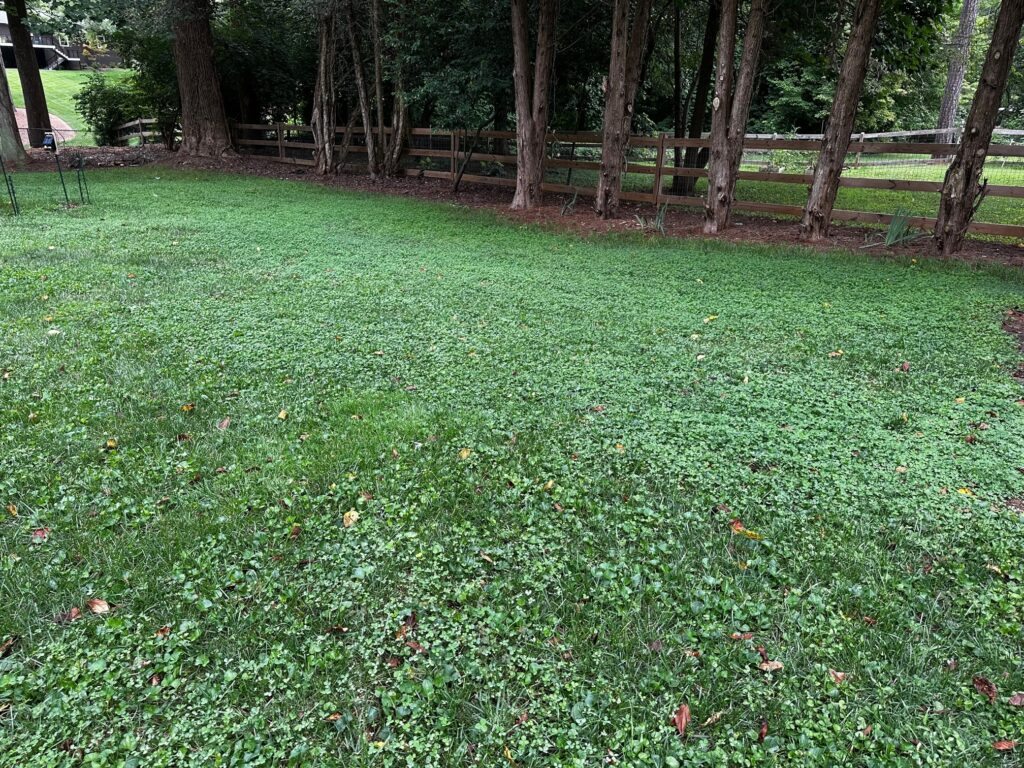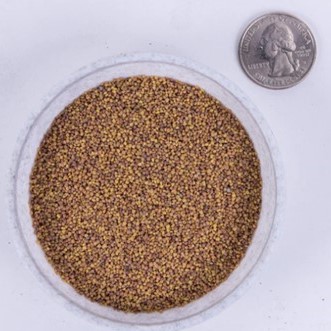About this time last year I was seeking a new solution to an annual ritual with predictably frustrating results. I’m referring to my Fall habit of preparing the lawn, seeding new grass, tending it carefully, being pleased with the results and then watching it all die just as soon as the heat of the next Summer arrives.

One of my colleagues here at FSG suggested that I overseed my lawn with clover as a potential solution to my problem. I did a little research and found out that clover used to be included in lawn seed mixes to help fill in the gaps between grass blades. I figured it was worth a shot and got busy with the experiment!.
Side Note #1: Most lawn seed companies removed clover from their mixes as “weed and feed” products became more popular. These target broadleaf “weeds” and would kill clover as a result.

My goals for my lawn are very simple:
- Something green that looks nice and is good to walk on and can be that way using only organic growing practices
- Must be low maintenance once established…if I’m honest “no maintenance” is really the goal outside of the occasional mowing and trimming
- Must be able to withstand the changes of season
- “Weeds” are fine…but some semblance of order is required too
After a year with a clover lawn I am happy to report these advantages:
- As advertised, clover spreads rapidly and fills in bare patches…it’s a sea of green with little white flowers!
- When allowed to grow a bit taller and flower it attracts sooooo many pollinators
- While part-sun, moist areas did the best, the clover also did well in both full-shade and full-sun areas of the lawn
- Surprisingly, the clover also held up relatively well in the small fenced area of our yard where our 50 lb dog takes care of his business
- Clover is a nitrogen fixer so while it’s growing it’s also providing nutrients to itself and anything else growing in the lawn

Some suggestions if you decide to give a clover lawn a shot:
- Mow less frequently and at your mower’s highest setting
- Don’t bag your clippings, let them fall to the ground and become a nutrient source as they break down
- Mow when pollinators are less active to avoid damaging their populations
Recommended steps for overseeding with clover in your lawn:
- Prepare your lawn for new seed via aeration or simply raking away thatch so that soil contact can be ensured
- If you’re overseeding with both clover and grass seed, make sure that clover is about 10% of your mix by weight. Mixing the two by hand in a bucket is easy and a spreader will make getting the mix onto the lawn quick and easy
- If you’re overseeding with just clover remember that it doesn’t take much. ¼-⅓ lb clover seed per 1000 ft2 is enough. As clover seeds are very small, hand spreading is required. To make this easier, I’d recommend mixing the clover seed in a bucket with sand and spreading that as a way to get more even coverage
- Until the seeds germinate and the clover is established, water when it doesn’t rain

Side Note #2: While the choice is yours, either crimson or white clover will work in a lawn. I chose white because my lawn already had some in it and also crimson clover tends to grow more vigorously. I didn’t want to have a lawn that my mower couldn’t handle.
Side Note #3: Remember the point above about clover flowers attracting lots of pollinators? Most of those are bees…so be sure to wear shoes or sandals when walking in the lawn!
In closing, for me, the clover lawn has been a big success and I was excited to share the results in this forum. If this sounds interesting to you please know that we sell clover (and grass) seeds at Fifth Season and would be happy to help you plan your own lawn experiment. Who knows, you may even find one with four leaves!
Cheers!

Ernest Deajardins says
Hello I’m interested in growing a clover lawn i have to mow my lawn almost twice a week and for some reason my lawn has mostly turned to crab grass that makes a mess and doesn’t look nice i do have some white clover in it as well
My lawn is about an acre to
1 1/2 acres not sure how much clover seed i need also not sure if the clover will chock out the crab grass
brian says
Thanks for your question and interest. Usually 4 lbs of seed per acre is recommended for establishing a lawn. I wouldn’t expect your clover to choke out crab grass. If you want to have the best results you’ll need to either pull or kill the crab grass! Best of luck.
Wayne Roser says
How Do u feed your lawn with weed & feed?
brian says
Thanks for your question. Weed & Feed products are fertilizers + herbicides and are synthetic. If you’re growing clover you should not use them as they will kill your clover. We recommend a balanced, organic fertilizer such as Harmony that we carry for lawn application. It’s best to fertilize when your lawn is actively growing. For most people, that’s spring and fall if they are growing a cool season grass such as fescue. Best of luck!